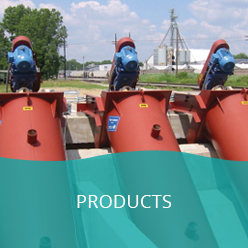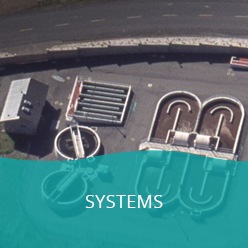Screening and grit removal are essential in wastewater treatment processes. They are the two main processes in the wastewater treatment facilities that help to keep the plant running efficiently and reduce maintenance costs. When it comes to looking at screening and grit removal, though, there are many different options to choose from. We’re going to take a look at the different screening and grit removal technologies to see what might be the best option for your wastewater treatment processes.
What is Screening and Grit Removal?
As we stated before, screening and grit removal are an important part of wastewater management. Here is a look at what screening and grit removal are when it comes to wastewater management.
Screening: Screening is a physical process that uses screens to catch larger, coarse solids. It typically removes items like plastic wrappers, rags, toys, and other trash that ultimately shouldn’t be flushed. The water will flow through the screen and the collected debris is washed and dewatered before it’s removed.
Grit Removal: Grit removal is the process of removing smaller, heavier inorganic materials that pass through the initial screening process. Sand, gravel, coffee grounds, and bone fragments are all a part of the debris that would be removed in this process. The water goes through a grit chamber, which causes heavy grit particles to settle to the bottom, where the debris is then collected and mechanically removed.
With both of these processes, it’s important to do the grit and screening removal properly in order to get an efficient result. If you are not doing this removal properly, then it can cause inefficiency and leave leftover debris in the water, which can cause many other issues within the process and for those using the water.
Screening Technology Methods
There are many different screening technology methods that you can choose from, and they all have their own pros and cons. We are going to take a look at each of these technologies to help you decide which is the best option for you.
Bar Screens
Bar screens are simple, reliable, and cost-effective, making them a great option for so many companies looking for a reliable but budget-friendly option. Another pro to opting for this screening technology is that it has the ability to handle high flow rates. With this said, some of the cons associated with this technology are the need for manual cleaning, which may be labor-intensive and not something that some wastewater management facilities may be able to do. Not only this, but there is a limitation to the removal of small debris, meaning that some of the minuscule debris could potentially be missed and may need to be followed up with another method.
Drum Screens
Drum screens offer a continuous operation with automated cleaning, which means there is little need for manual intervention. It’s also very effective at removing smaller solids that might be missed with other technologies. However, the initial cost is higher than some might want to pay, and it can also clog if it’s not properly maintained, so frequent maintenance is important.
Step Screens
Step screens have a compact footprint, and they can handle high debris loads very efficiently. On the other hand, moving parts in this technology require regular maintenance, which keeps it running effectively. From a sustainability standpoint, this technology has higher energy consumption than other options, which can cause higher bills and a greater environmental impact.
Fine Screens
Fine screens are known for their ability to remove very small particles. They also protect sensitive downstream equipment, which is essential for wastewater management companies that are looking for protection of their other equipment. Some of the cons to this option are that it’s prone to clogging, so it requires more maintenance and cleaning than other options.
Grit Removal Technologies
Now, we are going to take a look at the different grit removal technologies and compare them with their pros and cons. This will help you to decide which option might be best for your wastewater management business.
Grit Chambers/Detention Basins
Grit chambers or detention basins are known for their low-energy and simple design. It’s also great for larger grit particles and works efficiently to remove them. However, this technology requires more space and is less effective for finer grit, meaning that there may be a need to have another technology to go behind it.
Aerated Grit Chambers
Aerated grit chambers use continuous operation and good grit separation to keep up with effectively doing their job. It also reduces odor and sludge buildup, which can be an issue for other technologies. Some of the cons associated with this option are higher operational costs due to the aeration. There is also a more complex design and maintenance, which may require more manpower to maintain.
Vortex Grit Removal Systems
One of the best pros of getting a vortex grit removal system is the compact footprint, and it’s also best for removing both fine and coarse grit, making it quite universal for different needs. Overall, there are cons that come with this particular system as well, though. For example, there is a higher initial cost with this system, and it is also sensitive to flow variations, which means that it may require adjustments.
Hydroclones/Centrifugal Systems
Hydroclones and centrifugal systems are both great at fine-grit separation. It also has a small footprint with low energy consumption, making it a great option for sustainability. One of the drawbacks of these systems is the limited capacity, which means that for larger facilities, there could be a need to have multiple systems per facility.
What Should You Consider When Choosing a Technology?
When it comes to choosing a technology system that is best for you, it’s important to look at all of the factors. Here is a list of some of the top things you should consider when you are deciding on what system to use for your facility:
- Flow rate and the peak flow variations
- Integration with existing treatment processes
- Space and footprint constraints
- Type and size of debris it’s best suited for removing
- Maintenance requirements and operational costs
Choosing Your Screening and Grit Technology
If you’re in the market to choose a screening and grit technology, be sure to refer to this article on the different options that are available. Ultimately, it’s important to look into all of the considerations to ensure you are choosing the best option for your facility. With that being said, at Lakeside Equipment, we have a variety of options for wastewater removal facilities if you are looking to implement any of them. Contact us today or visit our website to take a look at what we have to offer and which option might be best for you.








